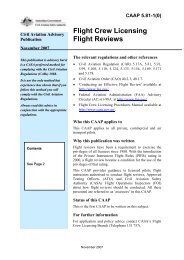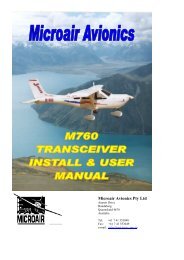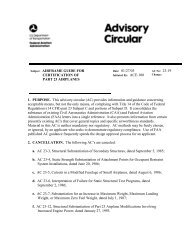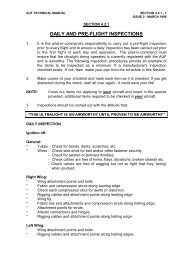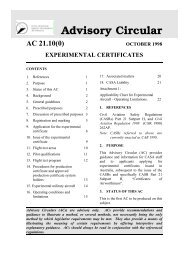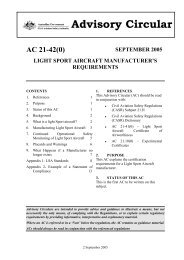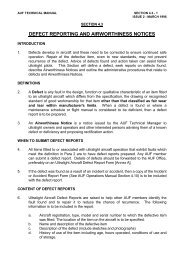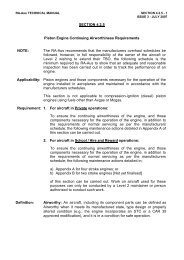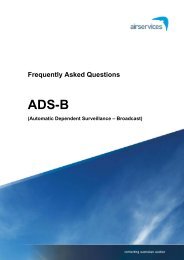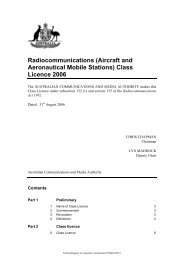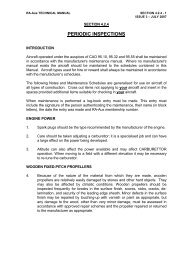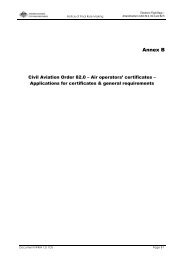Australian Ultralight Federation Inc - Fly Safe!
Australian Ultralight Federation Inc - Fly Safe!
Australian Ultralight Federation Inc - Fly Safe!
You also want an ePaper? Increase the reach of your titles
YUMPU automatically turns print PDFs into web optimized ePapers that Google loves.
<strong>Australian</strong> <strong>Ultralight</strong> <strong>Federation</strong> <strong>Inc</strong><br />
ARBN 070 931 645<br />
U35/59 Wollongong St<br />
PO Box 1265, Fyshwick ACT 2609<br />
Ph: 02 6280 4700 Fax: 02 6280 4775<br />
Email: tech@auf.asn.au<br />
10 August 2001<br />
MAJOR PORTION RULE ASSESSMENT FOR AUF AEROPLANES<br />
NOT LISTED IN OFFICIALLY APPROVED KIT LISTINGS<br />
CAO 95.55 para 1.5 (a) requires that the major portion of an AUF Amateur Built aeroplane is<br />
fabricated and assembled by a person who undertakes the construction solely for the persons own<br />
education and recreation. It also contains physical and performance requirements.<br />
Fabrication and Assembly Tables.<br />
CASA 21-29(0) promulgates the procedure for acceptance of an Amateur Built Aeroplane as being<br />
eligible under the Major Portion or 51% Rule if it has not already been declared eligible via the FAA<br />
Amateur Built Kit Listing, the CASA ABAA Listing or some other listing acceptable to the CASA. The<br />
AUF is required to abide by that system.<br />
A copy of that Advisory Circular AC 21.29(0) is attached.<br />
However, to aid the AUF in difficult areas of assessment such as when the CASA table produces<br />
an almost even result in builder/factory content, the AUF has produced a supplemental checklist<br />
which includes estimated manhours. The checklist is the same as the CASA checklist but it has<br />
two additional columns in which an assessor may include manhours.<br />
The AUF supplementary document follows the CASA document in this download.<br />
Applicants should remain aware that the CASA requirement (and therefore the AUF requirement)<br />
makes no allowance for manhours. The AUF document has been produced as an aid for the Tech<br />
Manager. Note that while this document as completed by a kit supplier will provide preliminary<br />
information, the document will need to be assessed by an AUF or AUF nominated independent<br />
assessor together with a physical evaluation of kit hardware before acceptance will be given, but at<br />
least the supplier completed version will provide sufficient for initial assessment.<br />
Construction Manual and Kit Parts List.<br />
On its own, the fabrication and assembly tables do not provide full information for AUF evaluation of<br />
a project and availability of the Assembly Manual coupled with the kit Parts List will give a greater<br />
insight into the project. Therefore, before a proper evaluation can be performed, a Parts List which<br />
is able to be defined by, say a date or configuration identifier together with a representative and<br />
identifiable Construction Manual is required. Preliminary versions will at least enable initial<br />
evaluation of the project to commence.<br />
An applicant should be clearly aware that an independent and physical on site AUF evaluation will<br />
most likely be required. The applicant must be prepared to bear costs for the complete exercise.<br />
R Hewitt-Cook<br />
Technical Manager<br />
O:\Technical\Major Portion Rule\Web Version\10 Aug\Cover Note.doc
Advisory Circular<br />
AC 21.29(0) JUNE 2000<br />
COMMERCIAL ASSISTANCE DURING<br />
CONSTRUCTION OF AMATEUR-BUILT<br />
EXPERIMENTAL AIRCRAFT AND AMATEUR-<br />
BUILT (ABAA) AIRCRAFT<br />
CONTENTS<br />
1. References 1<br />
2. Purpose 2<br />
3. Status of this AC 2<br />
4. Background 2<br />
5. Definitions 3<br />
6. Evaluation for major portion<br />
requirement 4<br />
7. Commercial assistance not<br />
requiring re-evaluation of the<br />
completed aircraft 5<br />
8. Commercial assistance requiring<br />
re-evaluation of the completed<br />
aircraft 6<br />
9. Sale of incomplete aircraft 6<br />
10. Non-evaluated kit aircraft 6<br />
11. Eligibility Statement 7<br />
12. Information supplied by industry<br />
to prospective customers 7<br />
13. Information supplied by industry<br />
to purchasers 7<br />
Appendix 1 8<br />
Appendix 2 16<br />
1. REFERENCES<br />
This AC is to be read in conjunction with<br />
Civil Aviation <strong>Safe</strong>ty Regulations<br />
(CASRs), Part 21 Subpart H, and Civil<br />
Aviation Regulations 1988 (CAR 1988)<br />
262AP, and AC 21.4(1) “Amateur-Built<br />
Experimental Aircraft - Certification”, and<br />
AC 21.11(0) “Amateur-Built (ABAA)<br />
Aircraft - Certification”.<br />
Note: CASRs referred to above are<br />
currently enacted as CAR<br />
1998.<br />
Advisory Circulars (ACs) are advisory only. ACs provide recommendations and<br />
guidance to illustrate a method, or several methods, not necessarily being the only<br />
method by which legislative requirements may be met. They also provide a means of<br />
illustrating the meaning of certain requirements by offering interpretive and<br />
explanatory guidance. ACs should always be read in conjunction with the referenced<br />
regulations.<br />
June 2000
2 AC 21.29(0): Commercial assistance during construction of amateur-built<br />
experimental aircraft and amateur-built (ABAA) aircraft<br />
2. PURPOSE<br />
This AC gives guidance as to the interpretation and determination of the major portion<br />
requirement for persons involved in the construction of amateur-built aircraft, the<br />
manufacture of kits designed to be assembled into aircraft by amateur-builders, builders of<br />
aircraft fabricated from plans for certification as amateur-built and persons providing<br />
assistance to amateur builders.<br />
3. STATUS OF THIS AC<br />
This is the first AC to be written on the subject.<br />
4. BACKGROUND<br />
4.1 CASR 21.191(g) provides for the issue of Experimental Certificates for the<br />
operation of amateur-built experimental aircraft. An Experimental Certificate is a Special<br />
Certificate of Airworthiness (CoA) (reference CASR 21.175). Special CoAs issued under<br />
CASR 21.190 provide for the operation of amateur-built (ABAA) aircraft (where ABAA<br />
means Amateur-Built Aircraft Acceptance under Civil Aviation Order CAO 101.28 or<br />
CASR 21.190). An amateur-built aircraft is defined as an aircraft, the MAJOR PORTION<br />
of which has been FABRICATED AND ASSEMBLED BY PERSONS who undertook the<br />
construction project SOLELY FOR THEIR OWN EDUCATION OR RECREATION”.<br />
4.2 This AC addresses the fabrication and assembly of amateur-built aircraft that are:<br />
(a) an original design of the builder;<br />
(b) built from purchased plans; or<br />
(c) built from a kit supplied by a kit manufacturer.<br />
An acceptable method for the determination of the major portion requirement is provided<br />
in this AC to determine whether an aircraft has actually been built by the person or persons<br />
who claim amateur-built status, and not merely for commercial gain.<br />
4.3 Some aircraft are constructed from plans, fabricated and assembled essentially from<br />
raw materials. Others are fabricated and assembled from kits supplied by a kit<br />
manufacturer. A mere mechanical assembly of a kit would clearly not meet the intent of the<br />
major portion requirement; the builder must undertake some of the fabrication work.<br />
4.4 The Authority does not certificate amateur-built experimental aircraft kits, nor<br />
approve amateur-built experimental aircraft kit manufacturers. Prior to the introduction of<br />
CASR Part 21, the Authority did approve <strong>Australian</strong> kit manufacturers under regulation 30<br />
of CAR 1988; however, this is not available to new entrants, and there is no similar<br />
provision in CASR Part 21.<br />
4.5 The Authority has introduced a system of evaluation of kits that, at the request of a<br />
kit manufacturer, the Authority will use to determine if a kit is capable of meeting the major<br />
portion requirement when assembled in accordance with the kit manufacturer’s instructions,<br />
and without further commercial assistance, could meet the major portion requirement. This<br />
evaluation should NOT be construed as meaning the kit or the kit manufacturer is<br />
CERTIFIED, CERTIFICATED, or APPROVED by the Authority, and it is not appropriate<br />
to represent it as such. Kits supplied by an <strong>Australian</strong> manufacturer approved as a<br />
June 2000
AC 21.29(0): Commercial assistance during construction of amateur-built 3<br />
experimental aircraft and amateur-built (ABAA) aircraft<br />
Certificate of Approval holder to manufacture under regulation 30 of CAR 1988 may<br />
continue to be represented as such.<br />
4.6 Persons contemplating purchasing a kit are strongly advised to determine that the kit<br />
has been assessed by the Authority, or another National Airworthiness Authority (NAA)<br />
whose assessments are acceptable to CASA (such as the Federal Aviation Administration<br />
(FAA) of the USA), as capable of meeting the major portion requirement. Failure to do this<br />
could result in the completed aircraft not being eligible for amateur-built certification.<br />
4.7 Persons contemplating building an aircraft from purchased plans or an original<br />
aircraft of their own design should be cognizant of the major portion requirement. The<br />
completed aircraft will still be subject to a major portion assessment for eligibility as an<br />
amateur-built aircraft.<br />
4.8 All completed aircraft must be evaluated by an authorised person or the Authority to<br />
establish that the major portion requirement has in fact been met, prior to the issue of the<br />
Special CoA.<br />
4.9 For further information on the procedures associated with the construction of<br />
amateur-built aircraft refer to:<br />
(a) AC 21.4 — Amateur-built Experimental Aircraft – Certification; and<br />
(b) AC 21.11 — Amateur-built (ABAA) Aircraft – Certification<br />
5. DEFINITIONS<br />
As used in this Advisory Circular, the following definitions apply:<br />
aircraft evaluation: the evaluation carried out for the purpose of determining if a specific<br />
amateur-built aircraft meets the major portion requirement of CASR 21.191(g) for<br />
Amateur-built Experimental Aircraft, or CAO 101.28 for Amateur-built (ABAA) Aircraft.<br />
commercial assistance: assistance in the building of an amateur-built aircraft in exchange<br />
for compensation. This does not include one builder helping another.<br />
compensation: payment by the amateur-builder applicant in cash, services, or other tender,<br />
to any person who provides assistance on a commercial basis in the building of an aircraft.<br />
checklist: the CASA Fabrication/Assembly Operation Checklist contained in Appendix 1 of<br />
this AC, is used as an aid in determining whether a manufacturer’s aircraft kit could meet<br />
the major portion requirement. It is also used for determining whether a completed aircraft<br />
is eligible for certification as an amateur-built aircraft.<br />
kit: a collection of prefabricated components, parts and materials that constitute all or a<br />
part of what is required to produce a finished aircraft.<br />
kit-built aircraft: this does not refer to amateur building; this is a primary category aircraft<br />
that meets the criteria of CASR 21.24(1)(a) and that was assembled by a person from a kit<br />
manufactured by the holder of a Production Certificate under CASR 21.184(1). The major<br />
portion requirement does not apply to such aircraft, which are eligible for an experimental<br />
certificate for the purpose of operating a kit-built aircraft under CASR 21.191(h). Further<br />
information is contained in section 16 of AC 21.4 “Amateur-built Experimental Aircraft –<br />
Certification”. However, aircraft manufactured from such kits may qualify as amateur-built<br />
if the major portion requirement is met.<br />
June 2000
4 AC 21.29(0): Commercial assistance during construction of amateur-built<br />
experimental aircraft and amateur-built (ABAA) aircraft<br />
kit evaluation: an evaluation by the Authority to determine whether an aircraft built from,<br />
and according to kit instructions, could meet the major portion requirement for amateurbuilt<br />
certification.<br />
letter of eligibility: a letter provided by the Authority to an aircraft kit manufacturer<br />
advising that the aircraft kit requested to be evaluated could meet the major portion<br />
requirement.<br />
major portion: as related to a Special CoA issued for the purpose of operating amateurbuilt<br />
aircraft, major portion means that when the aircraft is completed, more than 50% of<br />
the fabrication and assembly tasks have been carried out by an amateur builder or builders.<br />
plans-built aircraft: an aircraft that is constructed exclusively from plans/blueprints<br />
without the aid of purchased major sub-assemblies or pre-assembled kit components. This<br />
also includes aircraft of a builder’s original design.<br />
unacceptable commercial assistance: any commercial assistance that reduces the work<br />
carried out by the amateur builder or builders to less than the major portion of the aircraft<br />
construction.<br />
6. EVALUATION FOR MAJOR PORTION REQUIREMENT<br />
6.1 Initial Evaluation of Kits<br />
6.1.1 Aircraft kit manufacturers requesting a kit evaluation should submit a letter to the<br />
local CASA Office. Contact details for CASA Offices are given in AC 11.1 “Advisory<br />
Circulars - Guidelines”.<br />
6.1.2 The evaluation to determine compliance with the major portion requirement is<br />
carried out by an Airworthiness Inspector (AWI) from the CASA Office. When the kit is<br />
evaluated using the checklist in Appendix 1 as a guide and found to be able to comply with<br />
the major portion requirement, a Letter of Eligibility is sent to the kit manufacturer. The kit<br />
is then acceptable to be included in the list of eligible amateur-built aircraft kits that have<br />
been evaluated by the Authority, and contained in Appendix 2 of this AC.<br />
6.1.3 The purpose of the listing is to eliminate the duplication of evaluations for the major<br />
portion determination.<br />
6.1.4 If the kit manufacturer later offers an option or makes changes to the kit that<br />
decreases the amount of fabrication and assembly required by the builder, the manufacturer<br />
should request a new Letter of Eligibility. The kit manufacturer should provide a revised<br />
checklist and a description of the option or change to the Authority with drawings and or<br />
photographs as necessary. If the Authority determines that the revised kit still meets the<br />
major portion requirement, the Authority will issue a new Letter of Eligibility for the<br />
amended checklist without conducting a physical inspection or complete re-evaluation of<br />
the kit. If the Authority determines that the option or change was of sufficient magnitude, a<br />
physical inspection and re-evaluation of the kit will be carried out.<br />
6.2 Evaluation of Completed Kit Aircraft<br />
6.2.1 When an aircraft has been constructed from an eligible kit, and no further<br />
commercial assistance was used, a further major portion determination will not be required<br />
June 2000
AC 21.29(0): Commercial assistance during construction of amateur-built 5<br />
experimental aircraft and amateur-built (ABAA) aircraft<br />
6.2.2 A re-evaluation for compliance with the major portion requirement will be required<br />
if:<br />
(a) the aircraft was built using some prefabricated major components that are<br />
readily available from aircraft parts suppliers;<br />
(b) the aircraft was built using some salvaged or used sections from type<br />
certificated aircraft;<br />
(c) the aircraft was built from a kit for which there has not been a prior<br />
assessment for eligibility for amateur-built certification; or<br />
(d) the aircraft was built from a kit that had been changed by the kit manufacturer<br />
after the date of eligibility had been established.<br />
6.3 Evaluation of plans-built aircraft<br />
6.3.1 During final inspection for issue of a Special CoA, a plans-built aircraft must be<br />
evaluated for compliance with the major portion requirement. Where the builder’s records,<br />
data, and signed CASA Form 727 “Eligibility Statement – Amateur-Built Aircraft” provide<br />
evidence that the builder fabricated and assembled the major portion of the aircraft, the use<br />
of the checklist in Appendix 1 is not necessary. In all other cases, the checklist should be<br />
used.<br />
6.3.2 A person may provide commercial assistance to a builder of a plans-built aircraft or<br />
non-evaluated kit. This assistance or task must be listed in the KIT MANUFACTURER<br />
column on the checklist when the completed aircraft is presented for evaluation/certification<br />
to the authorised person or the CASA AWI.<br />
6.3.3 If the builder intends to utilise commercial assistance, the checklist can be submitted<br />
to the authorised person or the Authority prior to construction, listing the tasks or<br />
processes for which the commercial assistance is proposed. It should also show the<br />
intended fabrication and assembly tasks the builder is to perform. On the basis of this preconstruction<br />
checklist, a builder of a plans-built aircraft should be able to obtain an<br />
evaluation in writing from the authorised person or the Authority of the effect that the<br />
proposed commercial assistance will have on the major portion requirement for the<br />
completed aircraft.<br />
6.3.4 Factors which will affect the evaluation for compliance with the major portion<br />
requirement include:<br />
(a) using some prefabricated major components that are readily available from<br />
aircraft parts suppliers; and<br />
(b) using some salvaged or used sections from type certificated aircraft.<br />
7. COMMERCIAL ASSISTANCE NOT REQUIRING RE-EVALUATION OF<br />
THE COMPLETED AIRCRAFT<br />
7.1 Commercial instructional assistance may be obtained by the amateur builder in the<br />
fabrication or assembly of specific parts and in the completion of certain tasks or processes<br />
involved in the construction of the aircraft. During all instructional activity, the amateur<br />
builder must be present to accomplish the instructional tasks and must accomplish all<br />
subsequent fabrication and assembly of parts for which instruction is being given. Tasks<br />
completed by the amateur-builder would be identified on the checklist under AMATEUR or<br />
in the assembly manual. For example, assume fabrication of the wing ribs is listed on the<br />
June 2000
6 AC 21.29(0): Commercial assistance during construction of amateur-built<br />
experimental aircraft and amateur-built (ABAA) aircraft<br />
checklist or in the assembly manual as a task to be completed by the amateur-builder.<br />
Instructional activity could be provided to build the first few ribs with the remainder to be<br />
completed by the amateur-builder.<br />
7.2 Commercial assistance may be obtained for non-checklist items on a kit that has<br />
been evaluated by the Authority. A non-checklist item is a task or process that is not listed<br />
in the checklist. These items also include painting and the installation of interior upholstery<br />
or avionics. Such a task or process would not be required to be personally completed by<br />
the amateur-builder for the aircraft to be eligible for amateur-built certification.<br />
7.3 The amateur builder is not expected to have fabricated every component that makes<br />
up the completed aircraft. Non-checklist items include the fabrication of engines,<br />
propellers, wheels and brake assemblies, and standard aircraft hardware. However, if the<br />
installation of these items is checked in the AMATEUR column on the checklist, they must<br />
be accomplished by the builder.<br />
8. COMMERCIAL ASSISTANCE REQUIRING RE-EVALUATION OF THE<br />
COMPLETED AIRCRAFT<br />
For an evaluated kit, if commercial assistance is carried out on items listed in the checklist<br />
under AMATEUR, the major portion evaluation previously carried out by the Authority will<br />
be invalid for that specific aircraft project. Consequently, it may result in a complete reevaluation<br />
of the fabrication and assembly of the aircraft. This could put the amateur-built<br />
status of the aircraft in jeopardy. In other words, the aircraft will be treated as a nonevaluated<br />
kit and subject to complete evaluation by an authorised person or the Authority<br />
when presented for certification as an amateur-built aircraft.<br />
9. SALE OF INCOMPLETE AIRCRAFT<br />
Commercial assistance does not include the instance where an incomplete aircraft is sold to<br />
another builder and the second or subsequent builder completes the aircraft. In such a case,<br />
the work carried out by the first builder will count toward completion of the major portion<br />
by the second builder. The second or subsequent builder should obtain as much detailed<br />
information and documentation, e.g. logbooks, material receipts, photographs, etc. from the<br />
original builder as possible. This information will be helpful in the authorised person’s, or<br />
the Authority’s, determination for the major portion requirement of the aircraft.<br />
10. NON-EVALUATED KIT AIRCRAFT<br />
An aircraft constructed from a non-evaluated kit must be evaluated upon completion for<br />
compliance with the major portion requirements by an authorised person or CASA using the<br />
CASA Fabrication/Assembly Operation Checklist in Appendix 1.<br />
11. ELIGIBILITY STATEMENT<br />
The CASA Form No 727 “Eligibility Statement – Amateur-built Aircraft”, is one of the<br />
forms required to be submitted by the applicant for a Special CoA for the purpose of<br />
operating an amateur-built aircraft. It includes sections for the builder(s) and aircraft<br />
information along with the applicant’s declaration certifying that all statements and answers<br />
are complete and true. It also provides notice of the potential penalty that could be applied<br />
June 2000
AC 21.29(0): Commercial assistance during construction of amateur-built 7<br />
experimental aircraft and amateur-built (ABAA) aircraft<br />
if false or fraudulent statements are made. Copies of the CASA Form 727 are available<br />
from CASA Offices.<br />
12. INFORMATION SUPPLIED BY INDUSTRY TO PROSPECTIVE<br />
CUSTOMERS<br />
Kit manufacturers are encouraged to include in their information packages a document<br />
explaining the intent and purpose of the amateur-built requirements. Prospective customers<br />
would then be made aware of their responsibility and limitations under the Regulations. The<br />
information package should summarise the process used to determine kit eligibility and the<br />
inspection of the completed aircraft. It should also advise potential customers of the<br />
statement that they must sign certifying that they fabricated and assembled the major<br />
portion of the aircraft. Additionally, the customer should be advised of the need for and the<br />
availability of flight training, as well as the value of membership of organisations such as the<br />
Sport Aircraft Association of Australia (SAAA).<br />
13. INFORMATION SUPPLIED BY INDUSTRY TO PURCHASERS<br />
Kit manufacturers are encouraged to include a copy of the amateur-built Regulations and to<br />
advise the purchaser of the requirement for applicants to certify that they have fabricated<br />
and assembled the major portion of the aircraft for their own education or recreation. In<br />
addition to the aircraft assembly manual, the kit manufacturer should reference this AC<br />
regarding acceptable commercial assistance. Manufacturers should inform purchasers of the<br />
help available to them through organisations such as the SAAA.<br />
Richard G. Yates<br />
Assistant Director<br />
Aviation <strong>Safe</strong>ty Standards<br />
June 2000
8 AC 21.29(0): Commercial assistance during construction of amateur-built<br />
experimental aircraft and amateur-built (ABAA) aircraft<br />
GUIDANCE.<br />
CASA Fabrication/Assembly Operation Checklist<br />
Appendix 1<br />
1. This form may be used by any person to establish the eligibility of an aircraft to be<br />
issued with a Special CoA, for the purpose of operating as an amateur-built experimental<br />
aircraft. Prepare the form as follows:<br />
2. Enter the company name and address, aircraft model, (by name and/or number),<br />
document name and date (manufacturer’s parts list, assembly manual, etc., with latest<br />
revision) and type of aircraft (land, sea, fixed-wing, rotorcraft, etc.).<br />
3. Mark the specific tasks required to fabricate and assemble the aircraft. Mark, an “X”<br />
under the column heading “Accomplished By” in the appropriate space when the task is<br />
carried out by the AMATEUR. If the task is carried out by the kit manufacturer or by a<br />
person providing commercial assistance, a mark will be placed in the kit manufacturer<br />
column. Additional blank lines are provided to list any tasks not on the checklist. If a task is<br />
listed and not applicable to the construction of the aircraft enter N/A in the appropriate<br />
space.<br />
4. Use the comments area to enter any additional comments, information or statements,<br />
as necessary.<br />
5. Print or type the name of the person carrying out the evaluation of the kit or aircraft.<br />
6. The person carrying out the evaluation of the kit or aircraft should sign their name in<br />
the signature block.<br />
7. Enter the date the evaluation was carried out.<br />
8. To meet the major portion requirement, the number of check marks in the<br />
AMATEUR BUILDER column must exceed the number of check marks in the KIT<br />
MANUFACTURER column.<br />
9. For additional guidance or interpretation of requirements in unusual circumstances,<br />
contact your local CASA office.<br />
June 2000
AC 21.29(0): Commercial assistance during construction of amateur-built 9<br />
experimental aircraft and amateur-built (ABAA) aircraft<br />
Fabrication/Assembly Operation Checklist<br />
Company Name: ___________________________________________________________<br />
Address:<br />
_______________________________________________________________<br />
Aircraft Model: ____________________________________________________________<br />
Document Name and Date:___________________________________________________<br />
Type of Aircraft: __________________________________________________________<br />
Fuselage<br />
1. Fabricate Special Tools or Fixtures<br />
2. Fabricate Longitudinal Members, Cores or Shells<br />
3. Fabricate Bulkheads or Cross Members<br />
4. Assemble Fuselage Basic Structure<br />
5. Fabricate Brackets and Fittings<br />
6. Install Brackets and Fittings<br />
7. Fabricate Cables, Wire and Lines<br />
8. Install Cables, Wires and Lines<br />
9. Fabricate Fuselage Covering or Skin<br />
10. Install Fuselage Covering or Skin<br />
11. Fabricate Windshield/Windows/Canopy<br />
12. Install Windshield/Windows/Canopy<br />
Kit<br />
Manufacturer<br />
Amateur<br />
Builder<br />
June 2000
10 AC 21.29(0): Commercial assistance during construction of amateur-built<br />
experimental aircraft and amateur-built (ABAA) aircraft<br />
Wings<br />
1. Fabricate Special Tools or Fixtures<br />
2. Fabricate Wing Spars<br />
3. Fabricate Wings Ribs or Cores<br />
4. Fabricate Wing Leading and Trailing Edge<br />
5. Fabricate Drag/Anti-Drag Truss Members<br />
6. Fabricate Wing Brackets and Fittings<br />
7. Fabricate Wing Tips<br />
8. Assemble Basic Wing Structures<br />
9. Install Wing Leading/Trailing Edge and Tips<br />
10. Install Drag/Anti-Drag Truss<br />
11. Fabricate Cables, Wires and Lines<br />
12. Install Cables, Wires and Lines<br />
13. Fabricate Wing Covering or Skin<br />
14. Install Wing Covering or Skin<br />
15. Fabricate Wing Struts/Wires<br />
16. Install and Rig Wings and Struts<br />
Kit<br />
Manufacturer<br />
Amateur<br />
Builder<br />
Flight Controls<br />
1. Fabricate Special Tools or Fixtures<br />
2. Fabricate Aileron Spars<br />
3. Fabricate Aileron Ribs or Cores<br />
4. Assemble Aileron Structure<br />
5. Fabricate Aileron Leading and Trailing Edge<br />
Kit<br />
Manufacturer<br />
Amateur<br />
Builder<br />
June 2000
AC 21.29(0): Commercial assistance during construction of amateur-built 11<br />
experimental aircraft and amateur-built (ABAA) aircraft<br />
6. Assemble Aileron Leading and Trailing Edge<br />
7. Fabricate Aileron Brackets and Fittings<br />
8. Install Aileron Brackets and Fittings<br />
9. Fabricate Aileron Covering or Skin<br />
10. Install Aileron Covering or Skin<br />
11. Fabricate Aileron Trim Tab<br />
12. Install Aileron Trim Tab<br />
13. Install and Rig Aileron<br />
14. Fabricate Flap Spars<br />
15. Fabricate Flap Ribs or Cores<br />
16. Assemble Flap Structure<br />
17. Fabricate Flap Leading and Trailing Edge<br />
18. Assemble Flap Leading and Trailing Edge<br />
19. Fabricate Flap Brackets and Fittings<br />
20. Install Flap Brackets and Fittings<br />
21. Fabricate Flap Covering or Skin<br />
22. Install Flap Covering or Skin<br />
23. Install and Rig Flap<br />
24. Fabricate Elevator Spars<br />
25. Fabricate Elevator Ribs or Cores<br />
26. Assemble Elevator Structure<br />
27. Fabricate Elevator Leading and Trailing Edge<br />
28. Assemble Elevator Leading and Trailing Edge<br />
29. Fabricate Elevator Brackets and Fittings<br />
30. Install Elevator Brackets and Fittings<br />
31. Fabricate Elevator Covering or Skin<br />
32. Install Elevator Covering or Skin<br />
33. Fabricate Elevator Trim Tab<br />
34. Install Elevator Trim Tab<br />
35. Install and Rig Elevator<br />
36. Fabricate Rudder Spars<br />
37. Fabricate Rudder Ribs or Cores<br />
June 2000
12 AC 21.29(0): Commercial assistance during construction of amateur-built<br />
experimental aircraft and amateur-built (ABAA) aircraft<br />
38. Assemble Rudder Structure<br />
39. Fabricate Rudder Leading and Trailing Edge<br />
40. Assemble Rudder Leading and Trailing Edge<br />
41. Fabricate Rudder Brackets and Fittings<br />
42. Install Rudder Brackets and Fittings<br />
43. Fabricate Rudder Covering or Skin<br />
44. Install Rudder Covering or Skin<br />
45. Fabricate Rudder Trim Tab<br />
46. Install Rudder Trim Tab<br />
47. Install and Rig Rudder<br />
Empennage<br />
1. Fabricate Special Tools or Fixtures<br />
2. Fabricate Spars<br />
3. Fabricate Ribs or Cores<br />
4. Fabricate Leading and Trailing Edges<br />
5. Fabricate Tips<br />
6. Fabricate Brackets and Fittings<br />
7. Assemble Empennage Structures<br />
8. Install Leading/Trailing Edges and Tips<br />
9. Install Fittings<br />
10. Fabricate Cables, Wires and Lines<br />
11. Install Cables, Wires and Lines<br />
12. Fabricate Empennage Covering or Skin<br />
13. Install Empennage Covering or Skin<br />
Kit<br />
Manufacturer<br />
Amateur<br />
Builder<br />
June 2000
AC 21.29(0): Commercial assistance during construction of amateur-built 13<br />
experimental aircraft and amateur-built (ABAA) aircraft<br />
Canard<br />
1. Fabricate Canard<br />
2. Assemble Canard Structure<br />
3. Install and Rig Canard<br />
Kit<br />
Manufacturer<br />
Amateur<br />
Builder<br />
Landing Gear<br />
1. Fabricate Special Tools or Fixtures<br />
2. Fabricate Struts<br />
3. Fabricate Brakes System<br />
4. Fabricate Retraction System<br />
5. Fabricate Cables, Wires and Lines<br />
6. Assemble Wheels, Brakes, Tires and Landing Gear<br />
7. Install Landing Gear System Components<br />
Kit<br />
Manufacturer<br />
Amateur<br />
Builder<br />
Propulsion<br />
1. Fabricate Special Tools or Fixtures<br />
2. Fabricate Engine Mount<br />
3. Fabricate Engine Cooling System/Baffles<br />
4. Fabricate Induction System<br />
5. Fabricate Exhaust System<br />
6. Fabricate Engine Controls<br />
7. Fabricate Brackets and Fittings<br />
8. Fabricate Cables, Wires and Lines<br />
9. Assemble Engine<br />
10. Install Engine and Items Listed Above<br />
11. Fabricate Engine Cowling<br />
Kit<br />
Manufacturer<br />
Amateur<br />
Builder<br />
June 2000
14 AC 21.29(0): Commercial assistance during construction of amateur-built<br />
experimental aircraft and amateur-built (ABAA) aircraft<br />
12. Install Engine Cowling<br />
13. Fabricate Propeller<br />
14. Install Propeller<br />
15. Fabricate Fuel Tank<br />
16. Install Fuel Tank<br />
17. Fabricate Fuel System Components<br />
18. Install Fuel System Components<br />
Main Rotor Drive Systems and Control Mechanism(s)<br />
1. Fabricate Special Static and Dynamic Rotor Rigging<br />
Tools<br />
2. Fabricate/Assemble Main Rotor Drive Train<br />
3. Install Main Rotor Drive Train Assembly<br />
4. Fabricate/Assemble Main Rotor Shaft and Hub<br />
Assembly<br />
5. Install Main Rotor Shaft and Hub Assembly<br />
6. Align Main Rotor Shaft, Drive Train Shaft and Hub<br />
Assembly<br />
7. Fabricate Main Rotor Rotating Controls<br />
8. Install Main Rotor Rotating Controls<br />
9. Fabricate Main Rotor Non-Rotating Controls<br />
10. Rig Main Rotor Rotating and Non-Rotating Controls<br />
11. Fabricate Main Rotor Blades<br />
12. Install Main Rotor Blades on Rotor Hub<br />
13. Statically Balance and Rig Main Rotor System<br />
14. Dynamically Track and Balance Main Rotor System<br />
Kit<br />
Manufacturer<br />
Amateur<br />
Builder<br />
June 2000
AC 21.29(0): Commercial assistance during construction of amateur-built 15<br />
experimental aircraft and amateur-built (ABAA) aircraft<br />
Tail Rotor Drive Systems and Control Mechanism(s)<br />
1. Fabricate Special Static Tail Rotor Rigging Tools<br />
2. Fabricate Vertical Trim Fin<br />
3. Install Vertical Trim Fin<br />
4. Fabricate Horizontal Stabiliser<br />
5. Install Horizontal Stabiliser<br />
6. Fabricate Tail Rotor Drive System<br />
7. Install Tail Rotor Drive System<br />
8. Fabricate Tail Cone or Frame<br />
9. Install and Rig Tail Cone or Frame<br />
10. Rig Vertical Trim Fin<br />
11. Fabricate Tail Rotor Shaft and Hub Assembly<br />
12. Install Tail Rotor Shaft and Hub Assembly<br />
13. Fabricate Tail Rotor Rotating and Non-Rotating<br />
Controls<br />
14. Rig Tail Rotor Rotating and Non-Rotating Controls<br />
15. Fabricate/Assemble Tail Rotor Blades<br />
16. Install Tail Rotor Blades<br />
17. Statically Balance and Rig Tail Rotor System<br />
18. Dynamically Track and Balance Tail Rotor System<br />
Cockpit/Interior<br />
1. Fabricate Instrument Panel<br />
2. Install Instrument Panel and Instruments<br />
3. Fabricate Seats<br />
4. Install Seats<br />
5. Fabricate Electrical Wiring, Controls and Switches<br />
6. Install Electrical System, Controls and Switches<br />
Totals<br />
Add total number of marks in each of the columns<br />
Kit<br />
Manufacturer<br />
Kit<br />
Manufacturer<br />
Amateur<br />
Builder<br />
Amateur<br />
Builder<br />
June 2000
16 AC 21.29(0): Commercial assistance during construction of amateur-built<br />
experimental aircraft and amateur-built (ABAA) aircraft<br />
Appendix 2<br />
LISTING OF ELIGIBLE AMATEUR-BUILT AIRCRAFT KITS ASSESSED BY<br />
THE AUTHORITY<br />
(To be advised)<br />
Note: The listing of eligible kits assessed by the FAA is posted on FEDWORLD and may<br />
also be viewed via the Internet on the FAA Regulatory Support division home page at<br />
address http://www.mmac.jccbi.gov/afs/afs600/.<br />
June 2000
AUF VERSION OF<br />
FABRICATION/ASSEMBLY CHECKLIST<br />
Appendix1:<br />
Major Portion (51% Ruling) Check List<br />
1. Purpose.<br />
This appendix provides instructions for completing the form at Appendix 1<br />
2. Guidance.<br />
Appendix 1 may be used by any person to establish the eligibility of an aircraft as AUF<br />
Amateur Built for the purpose of operating as an amateur-built ultralight. Prepare the<br />
Appendix as follows:<br />
a. Enter the name and address, aircraft model, (by name and/or number), document name<br />
and date (manufacturer’s parts list, assembly manual, etc., with latest revision) and type<br />
of aircraft (land, sea, fixed-wing, rotorcraft, etc.).<br />
b. Mark the specific tasks required to fabricate and assemble the aircraft.<br />
• When the task is performed by the AMATEUR BUILDER, mark an “X” in the<br />
appropriate space under the Amateur “check” column<br />
• If the task is performed by the kit manufacturer or by a person providing commercial<br />
assistance, an “X” mark will be placed in the KIT MANUFACTURER “check” column<br />
• Enter the estimated manhour content against the checked entry in the appropriate<br />
MANUFACTURER/AMATEUR BUILDER columns<br />
• If both the kit manufacturer and the builder have an input, check both columns and<br />
enter the manhour contents. Correspondence will be required to assess the<br />
evaluation of the manhour content.<br />
• Additional blank lines are provided to list any tasks not on the checklist. If a task is<br />
listed and not applicable to the construction of the aircraft enter N/A in the appropriate<br />
space.<br />
c. Use the comments area to enter any additional comments, information or statements, as<br />
necessary.<br />
d. Print or type the name of the person performing the evaluation of the kit or aircraft.<br />
e. The person performing the evaluation of the kit or aircraft should sign their name in the<br />
signature block.<br />
f. Enter the date the evaluation was performed.<br />
g. To meet the major portion requirement, the number of check marks in the Amateur<br />
Builder colmn should exceed the number of marks in the kit manufacturer column, but<br />
allowances may be made for manhour content in the final evaluation.
APPENDIX 1:<br />
2<br />
Fabrication/Assembly Operation Checklist<br />
Name of Applicant:<br />
Address of Applicant:<br />
Aircraft Model:<br />
Document Name and Date:<br />
Type of Aircraft:<br />
Fuselage<br />
1. Fabricate Special Tools or Fixtures<br />
2. Fabricate Longitudinal Members, Cores or Shells<br />
3. Fabricate Bulkheads or Cross Members<br />
4. Assemble Fuselage Basic Structure<br />
5. Fabricate Brackets and Fittings<br />
6. Install Brackets and Fittings<br />
7. Fabricate Cables Wire and Lines<br />
8. Install Cables, Wires and Lines<br />
9. Fabricate Fuselage Covering or Skin<br />
10. Install Fuselage Covering or Skin<br />
11. Fabricate Windshield/Windows/Canopy<br />
12. Install Windshield/Windows/Canopy<br />
Kit Manufacturer Amateur Builder<br />
Check Manhours Check<br />
TOTAL This group (Must be completed)<br />
Wings<br />
1. Fabricate Special Tools or Fixtures<br />
2. Fabricate Wing Spars<br />
3. Fabricate Wings Ribs or Cores<br />
4. Fabricate Wing Leading and Trailing Edge<br />
5. Fabricate Drag/Anti-Drag Truss Members<br />
6. Fabricate Wing Brackets and Fittings<br />
7. Fabricate Wing Tips<br />
8. Assemble Basic Wing Structure<br />
9. Install Wing Leading/Trailing Edge and Tips<br />
10. Install Drag/Anti-Drag Truss<br />
11. Fabricate Cables, Wires and Lines<br />
12. Install Cables, Wires and Lines<br />
13. Fabricate Wing Covering or Skin<br />
14. Install Wing Covering or Skin<br />
15. Fabricate Wing Struts/Wires<br />
16. Install and Rigs Wings and Struts<br />
Kit Manufacturer Amateur Builder<br />
Check Manhours Check<br />
TOTAL This group (Must be completed)
3<br />
Flight Controls<br />
1. Fabricate Special Tools or Fixtures<br />
2. Fabricate Aileron Spars<br />
3. Fabricate Aileron Ribs or Cores<br />
4. Assemble Aileron Structure<br />
5. Fabricate Aileron Leading and Trailing Edge<br />
6. Install Aileron Leading and Trailing Edge<br />
7. Fabricate Aileron Brackets and Fittings<br />
8. Install Aileron Brackets and Fittings<br />
9. Fabricate Aileron Covering or Skin<br />
10. Install Aileron Covering or Skin<br />
11. Fabricate Aileron Trim Tab<br />
12. Install Aileron Trim Tab<br />
13. Install and Rib Aileron<br />
14. Fabricate Flap Spars<br />
15. Fabricate Flap Ribs or Cores<br />
16. Assemble Flap Structure<br />
17. Fabricate Flap Leading and Trailing Edge<br />
18. Assemble Flap Leading and Trailing Edge<br />
19. Fabricate Flap Brackets and Fittings<br />
20. Install Flap Brackets and Fittings<br />
21. Fabricate Flap Covering or Skin<br />
22. Install Flap Covering or Skin<br />
23. Install and Rig Flap<br />
24. Fabricate Elevator Spars<br />
25. Fabricate Elevator Ribs or Cores<br />
26. Assemble Elevator Structure<br />
27. Fabricate Elevator Leading and Trailing Edge<br />
28. Assemble Elevator Leading and Trailing Edge<br />
29. Fabricate Elevator Brackets and Fittings<br />
30. Install Elevator Brackets and Fittings<br />
31. Fabricate Elevator Covering or Skin<br />
32. Install Elevator Covering or Skin<br />
33. Fabricate Elevator Trim Tab<br />
34. Install Elevator Trim Tab<br />
35. Install and Rig Elevator<br />
36. Fabricate Rudder Seals<br />
37. Fabricate Rudder Ribs or Cores<br />
38. Assemble Rudder Structure<br />
39. Fabricate Rudder Leading and Trailing Edges<br />
40. Assemble Rudder Leading and Trailing Edges<br />
41. Fabricate Rudder Brackets and Fittings<br />
42. Install Rudder Brackets and Fittings<br />
43. Fabricate Rudder Covering or Skin<br />
44. Install Rudder Covering or Skin<br />
45. Fabricate Rudder Trim Tab<br />
46. Install Rudder Trim Tab<br />
47. Install and Rib Rudder<br />
Kit Manufacturer Amateur Builder<br />
Check Manhours Check<br />
TOTAL This group (Must be completed)
4<br />
Empennage<br />
1. Fabricate Special Tools or Fixtures<br />
2. Fabricate Spars<br />
3. Fabricate Ribs or Cores<br />
4. Fabricate Leading and Trailing Edges<br />
5. Fabricate Tips<br />
6. Fabricate Brackets and Fittings<br />
7. Assemble Empennage Structures<br />
8. Install Leading/Trailing Edges and Tips<br />
9. Install Fittings<br />
10. Fabricate Cables, Wires and Lines<br />
11. Install Cables, Wires and Lines<br />
12. Fabricate Empennage Covering or Skin<br />
13. Install Empennage Covering or Skin<br />
Kit Manufacturer Amateur Builder<br />
Check Manhours Check<br />
TOTAL This group (Must be completed)<br />
Canard (If Applicable)<br />
1. Fabricate Canard<br />
2. Assemble Canard Structure<br />
3. Install and Rig Canard<br />
Kit Manufacturer Amateur Builder<br />
Check Manhours Check<br />
TOTAL This group (Must be completed)<br />
Landing Gear<br />
1. Fabricate Special Tools or Fixtures<br />
2. Fabricate Struts<br />
3. Fabricate Brakes System<br />
4. Fabricate Retraction System<br />
5. Fabricate Cables, Wires and Lines<br />
6. Assemble Wheels, Brakes, Tires and Landing Gear<br />
7. Install Landing Gear System Components<br />
Kit<br />
Amateur Builder<br />
Manufacturer<br />
Check Manhours Check<br />
TOTAL This group (Must be completed)
Propulsion<br />
5<br />
1. Fabricate Special Tools or Fixtures<br />
2. Fabricate Engine Mount<br />
3. Fabricate Engine Cooling System/Baffles<br />
4. Fabricate Induction System<br />
5. Fabricate Exhaust System<br />
6. Fabricate Engine Controls<br />
7. Fabricate Brackets and Fittings<br />
8. Fabricate Cables, Wires and Lines<br />
9. Assemble Engine<br />
10. Install Engine and Items Listed Above<br />
11. Fabricate Engine Cowling<br />
12. Install Engine Cowling<br />
13. Fabricate Propeller<br />
14. Install Propeller<br />
15. Fabricate Fuel Tank<br />
16. Install Fuel Tank<br />
17. Fabricate Fuel System Components<br />
18. Install Fuel System Components<br />
Kit Manufacturer Amateur Builder<br />
Check Manhours Check<br />
TOTAL This group (Must be completed)<br />
Cockpit/Interior<br />
1. Fabricate Instrument Panel<br />
2. Install Instrument Panel and Instruments<br />
3. Fabricate Seats<br />
4. Install Seats<br />
5. Fabricate Electrical Wiring, Controls and Switches<br />
6. Install Electrical System, Controls and Switches<br />
Kit Manufacturer Amateur Builder<br />
Check Manhours Check<br />
TOTAL This group (Must be completed)<br />
Grand Totals<br />
Total of all group totals in each<br />
column (Must be Completed)<br />
Evaluation Performed By:<br />
Signature and Date<br />
Name (Print)<br />
Address:



